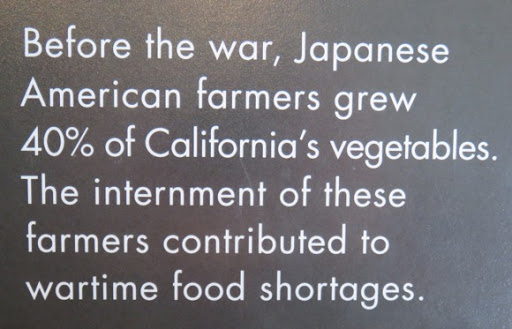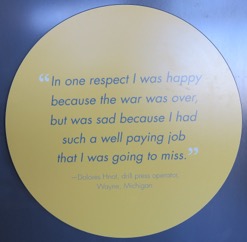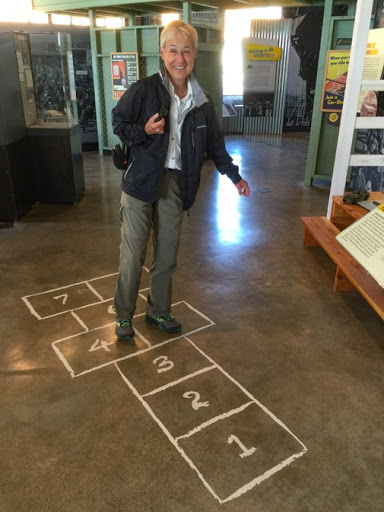The glaciers are disappearing from Glacier National Park, the Everglades are shrinking and Betty Soskin is 94 years old and, as she herself says,’ my shelf life is short.’ And why should you care? Well, she’s the oldest Ranger in the National Park system and gives a smashingly good presentation at the Rosie the Riveter National Historical Site. You’d better get here soon to hear her talk.
Back in 2012, the last time we were in the San Francisco area, we heard about the Rosie The Riveter National Historical Site and wanted to see it but also heard that it was still a work in progress. At that time it was just a few billboards and kiosks. Today it’s a full-fledged National park site with movies, artifacts, hands-on displays (remember hop scotch - my feet are way too big for this one),
and a full museum. And, of course, it has Betty.
The first question is - why was Richmond, CA chosen for this national historical site? Two reasons: Richmond still has so many surviving sites and structures from the World War II years that can help tell the diverse stories of the home front: stories about the mobilization of American industry, about the changes in production techniques, stories about the migrations of whole groups to factory towns. Secondly the changes that took place in Richmond presaged many changes that were to come in America as a whole in the future: the struggle for women’s and minority rights; the growth of the labor movement; the growth of pre-paid medical care; advances in early childhood education and day care; recycling and rationing; major shifts in population; and changes in arts and culture.

Yep, Richmond has it all. Let’s go explore. Here are some facts about Richmond during the war. The four Richmond shipyards produced 747 ships, more than any other shipyard complex in the country. Richmond was also home to over 56 different war industries, more than any other city of its size in the United States. The city grew from less than 24,000 people in 1940 to nearly 100,000 people by 1943, overwhelming the available housing, roads, schools, businesses and community services. At the same time, Executive Order 9066 forcibly removed Japanese and Japanese-American residents from the area, disrupting Richmond’s thriving cut-flower industry. The war truly touched every aspect of civilian life on the home front.

There were displays about the war and mobilization itself throughout the US. And there were displays about the war in Richmond and its effects. It has marvelous artifacts, pins, an old Jeep in a crate, hats, uniforms, Victory Garden cookbooks, signs, etc. But - they had a riveting tool that you could try out, a welding mask that you could put on and see the welding being done. Cute little things like that. Films show America during the war, Richmond and its changes during the war, the Japanese and their internment. But, finally, the creme de la creme - it has Betty

Take a close look at the poster above and below. What’s missing? Who is not portrayed? If you guessed African Americans, you can go to the head of the class. Rosie was always a white woman. What happened to all the African Americans who worked for the war effort? Whitewashed out. And, that’s Betty’s story as a young African American clerk in the segregated African American union hall.
'I settled in the greater Bay Area as a six-year-old in 1927. When I graduated from high school in 1938, my two opportunities for employment were working in agriculture or being a domestic servant. At that time, labour unions weren’t racially integrated and, during the war, I worked as a clerk for the segregated boilermakers’ union.'
Many years later she was a consultant on the design of this site and, as she read and looked at all the materials, she realized that her story was not being told here. Her thesis in her talk is that we have come a long way from her grandmother who was born before the Civil War as a slave to her role here as a Ranger and that the Kaiser ship building yards in Richmond were a huge part of this transformation.
Kaiser was an industrialist who first got involved in the war effort with clothing donations to Europe. But he thought he could build ships for the war effort and opened in Richmond. (Funny thing, he knew nothing about building ships, he had to learn this first - but he learned fast.) He changed from riveting hulls to welding because it took less physical strength can could be taught to all of the new employees he hired. He thought that his employees would miss fewer days of work if they had a pre-paid company health plan. (Did you know that more Americans died in Home Front accidents than died in the battlefields?) He thought that that they would be less stressed and miss fewer days if they had convenient quality day care for their kids. He thought they would be more of a team and happier if they had teams like basketball and volleyball. He was a hard-headed business man and instituted these things (common now) to make his workforce healthy and happy. Way to go Henry.


All he wanted was two hands - it didn’t matter the age, it didn’t matter the sex, it didn’t matter the color of the skin. He hired people with disabilities, he hired ‘little’ people to work in small spaces.
He just wanted two hands. As part of her talk Betty said that a young African American male down South prior to the war had to step aside into the street when a white was walking on the sidewalk. But when they got up here to work, they could sit anywhere they wanted to on the bus - many years before Rosa Parks. Richmond was a real cauldron for much we take for granted today.
We wandered through the museum and then out side where there is a fine trail around the water and the marinas. There is also a nice Rosie the Riveter Memorial on the walk with quotes from the war on it.
Marvelous Historical Site, wonderful talk by Betty.
San Francisco from the Rosie Site.














No comments:
Post a Comment